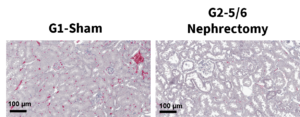An established preclinical model for mimicking renal failure after loss of kidney function in humans is the 5/6 nephrectomy mouse model. Common pathological features include glomerulosclerosis and tubulointerstitial fibrosis.
Establishment of CKD Mouse Model – 5/6 Nephrectomy
- Removal of right kidney
- Excision of 2/3 of the left kidney 1 week later
- Remaining tissue experiences high filtration & pressure, leading to glomerular sclerosis and fibrosis
-
Model schematic
-

-
Blood chemistry and pathology in CKD mouse model after nephrectomy (C57BL/6J)
-


C57BL/6J mice were subjected to the 5/6 nephrectomy, again over a period of 1 week. During the 12 weeks following completion of the surgeries, the nephrectomized mice shown in red were assessed for key parameters of kidney function, which indicate elevations in UREA and creatinine in serum compared to sham mice. Histopathology data by Masson staining at 12 weeks indicate glomerular hypertrophy, sclerosis, and fibrosis in the kidney of nephrectomized mice. ***p ≤ 0.001, ****p ≤ 0.0001.
-
Blood chemistry and pathology in CKD mouse model after nephrectomy (Balb/c)
-


Balb/c mice were subjected to the 5/6 nephrectomy, again over a period of 1 week. During the 12 weeks following completion of the surgeries, the nephrectomized mice shown in red were assessed for key parameters of kidney function, which indicate elevations in UREA and creatinine in serum compared to sham mice. Histopathology data by Masson staining at 12 weeks indicate glomerular hypertrophy, sclerosis, and fibrosis in the kidney of nephrectomized mice.



